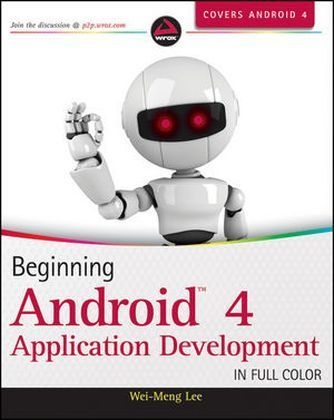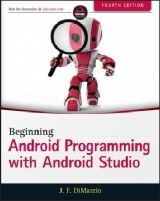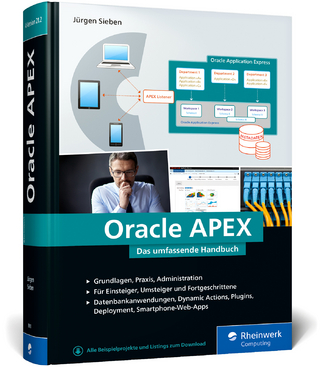
Beginning Android 4 Application Development
Wrox Press (Verlag)
978-1-118-19954-1 (ISBN)
- Titel ist leider vergriffen;
keine Neuauflage - Artikel merken
Understand Android OS for both smartphone and tablet programming This fast-paced introduction to the newest release of Android OS gives aspiring mobile app developers what they need to know to program for today's hottest Android smartphones and tablets. Android 4 OS is, for the first time, a single solution for both smartphones and tablets, so if you master the information in this helpful guide, you'll be well on your way to successful development for both devices. From using activities and intents and creating rich user interfaces to working with SMS, messaging APIs, and the Android SDK, what you need is here.
* Provides clear instructions backed by real-world programming examples * Begins with the basics and covers everything Android 4 developers need to know for both smartphones and tablets * Explains how to customize activities and intents, create rich user interfaces, and manage data * Helps you work with SMS and messaging APIs, the Android SDK, and using location-based services * Details how to package and publish your applications to the Android Market Beginning Android 4 Application Development pares down the most essential steps you need to know so you can start creating Android applications today.
Wei-Meng Lee is a technologist and founder of Developer Learning Solutions, a technology company specializing in hands-on training in the latest Microsoft and Apple technologies. He is the author of Beginning Android Application Development and Beginning iOS 5 Application Development, as well as many other technology books and articles.
INTRODUCTION xxi CHAPTER 1: GETTING STARTED WITH ANDROID PROGRAMMING 1 What Is Android? 2 Android Versions 2 Features of Android 3 Architecture of Android 4 Android Devices in the Market 6 The Android Market 8 The Android Developer Community 9 Obtaining the Required Tools 9 Android SDK 10 Installing the Android SDK Tools 11 Confi guring the Android SDK Manager 12 Eclipse 14 Android Development Tools (ADT) 15 Creating Android Virtual Devices (AVDs) 17 Creating Your First Android Application 20 Anatomy of an Android Application 29 Summary 33 CHAPTER 2: ACTIVITIES, FRAGMENTS, AND INTENTS 35 Understanding Activities 36 Applying Styles and Themes to an Activity 41 Hiding the Activity Title 41 Displaying a Dialog Window 42 Displaying a Progress Dialog 47 Displaying a More Sophisticated Progress Dialog 50 Linking Activities Using Intents 53 Resolving Intent Filter Collision 58 Returning Results from an Intent 59 Passing Data Using an Intent Object 63 Fragments 69 Adding Fragments Dynamically 73 Life Cycle of a Fragment 76 Interactions between Fragments 80 Calling Built-In Applications Using Intents 85 Understanding the Intent Object 89 Using Intent Filters 91 Adding Categories 96 Displaying Notifications 98 Summary 103 CHAPTER 3: GETTING TO KNOW THE ANDROID USER INTERFACE 105 Understanding the Components of a Screen 105 Views and ViewGroups 106 LinearLayout 107 AbsoluteLayout 115 TableLayout 116 RelativeLayout 117 FrameLayout 118 ScrollView 121 Adapting to Display Orientation 123 Anchoring Views 125 Resizing and Repositioning 127 Managing Changes to Screen Orientation 130 Persisting State Information during Changes in Confi guration 133 Detecting Orientation Changes 135 Controlling the Orientation of the Activity 135 Utilizing the Action Bar 136 Adding Action Items to the Action Bar 139 Customizing the Action Items and Application Icon 144 Creating the User Interface Programmatically 146 Listening for UI Notifications 148 Overriding Methods Defined in an Activity 149 Registering Events for Views 152 Summary 156 CHAPTER 4: DESIGNING YOUR USER INTERFACE WITH VIEWS 159 Using Basic Views 160 TextView View 160 Button, ImageButton, EditText, CheckBox, ToggleButton, RadioButton, and RadioGroup Views 161 ProgressBar View 171 AutoCompleteTextView View 177 Using Picker Views 179 TimePicker View 179 DatePicker View 184 Using List Views to Display Long Lists 191 ListView View 191 Using the Spinner View 199 Understanding Specialized Fragments 202 Using a ListFragment 202 Using a DialogFragment 207 Using a PreferenceFragment 210 Summary 214 CHAPTER 5: DISPLAYING PICTURES AND MENUS WITH VIEWS 219 Using Image Views to Display Pictures 219 Gallery and ImageView Views 220 ImageSwitcher 226 GridView 231 Using Menus with Views 234 Creating the Helper Methods 235 Options Menu 238 Context Menu 240 Some Additional Views 242 AnalogClock and DigitalClock Views 242 WebView 243 Summary 249 CHAPTER 6: DATA PERSISTENCE 251 Saving and Loading User Preferences 251 Accessing Preferences Using an Activity 252 Programmatically Retrieving and Modifying the Preferences Values 259 Changing the Default Name of the Preferences File 261 Persisting Data to Files 263 Saving to Internal Storage 263 Saving to External Storage (SD Card) 268 Choosing the Best Storage Option 271 Using Static Resources 272 Creating and Using Databases 273 Creating the DBAdapter Helper Class 273 Using the Database Programmatically 279 Pre-Creating the Database 285 Summary 289 CHAPTER 7: CONTENT PROVIDERS 293 Sharing Data in Android 293 Using a Content Provider 294 Predefi ned Query String Constants 300 Projections 303 Filtering 304 Sorting 305 Creating Your Own Content Providers 305 Using the Content Provider 314 Summary 319 CHAPTER 8: MESSAGING 321 SMS Messaging 321 Sending SMS Messages Programmatically 322 Getting Feedback after Sending a Message 325 Sending SMS Messages Using Intent 328 Receiving SMS Messages 329 Caveats and Warnings 344 Sending E-mail 345 Summary 347 CHAPTER 9: LOCATION-BASED SERVICES 351 Displaying Maps 352 Creating the Project 352 Obtaining the Maps API Key 353 Displaying the Map 355 Displaying the Zoom Control 358 Changing Views 361 Navigating to a Specific Location 363 Adding Markers 366 Getting the Location That Was Touched 369 Geocoding and Reverse Geocoding 371 Getting Location Data 375 Monitoring a Location 384 Project Building a Location Tracker 385 Summary 390 CHAPTER 10: NETWORKING 393 Consuming Web Services Using HTTP 393 Downloading Binary Data 396 Downloading Text Content 402 Accessing Web Services Using the GET Method 404 Consuming JSON Services 409 Sockets Programming 417 Summary 426 CHAPTER 11: DEVELOPING ANDROID SERVICES 429 Creating Your Own Services 429 Performing Long-Running Tasks in a Service 433 Performing Repeated Tasks in a Service 439 Executing Asynchronous Tasks on Separate Threads Using IntentService 442 Establishing Communication between a Service and an Activity 445 Binding Activities to Services 449 Understanding Threading 454 Summary 460 CHAPTER 12: PUBLISHING ANDROID APPLICATIONS 463 Preparing for Publishing 463 Versioning Your Application 464 Digitally Signing Your Android Applications 466 Deploying APK Files 471 Using the adb.exe Tool 471 Using a Web Server 474 Publishing on the Android Market 476 Summary 481 APPENDIX A: USING ECLIPSE FOR ANDROID DEVELOPMENT 483 Getting Around in Eclipse 483 Workspaces 483 Package Explorer 485 Using Projects from Other Workspaces 486 Using Editors within Eclipse 487 Understanding Eclipse Perspectives 490 Automatically Importing Packages 490 Using the Code Completion Feature 491 Refactoring 492 Debugging your Application 494 Setting Breakpoints 495 Dealing with Exceptions 497 APPENDIX B: USING THE ANDROID EMULATOR 499 Uses of the Android Emulator 499 Creating Snapshots 501 SD Card Emulation 502 Emulating Devices with Different Screen Sizes 504 Emulating Physical Capabilities 506 Sending SMS Messages to the Emulator 508 Making Phone Calls 509 Transferring Files into and out of the Emulator 511 Resetting the Emulator 513 APPENDIX C: ANSWERS TO EXERCISES 515 INDEX 521
| Erscheint lt. Verlag | 6.3.2012 |
|---|---|
| Sprache | englisch |
| Maße | 189 x 234 mm |
| Gewicht | 940 g |
| Themenwelt | Mathematik / Informatik ► Informatik ► Programmiersprachen / -werkzeuge |
| Informatik ► Software Entwicklung ► Mobile- / App-Entwicklung | |
| Informatik ► Weitere Themen ► Smartphones / Tablets | |
| ISBN-10 | 1-118-19954-5 / 1118199545 |
| ISBN-13 | 978-1-118-19954-1 / 9781118199541 |
| Zustand | Neuware |
| Informationen gemäß Produktsicherheitsverordnung (GPSR) | |
| Haben Sie eine Frage zum Produkt? |
aus dem Bereich



